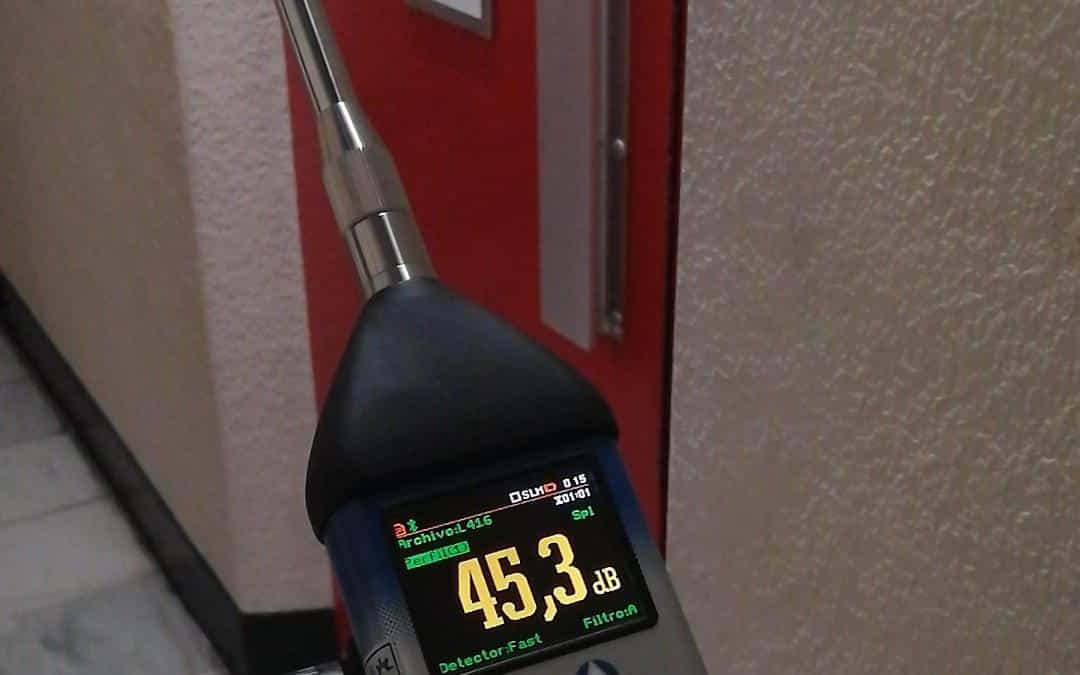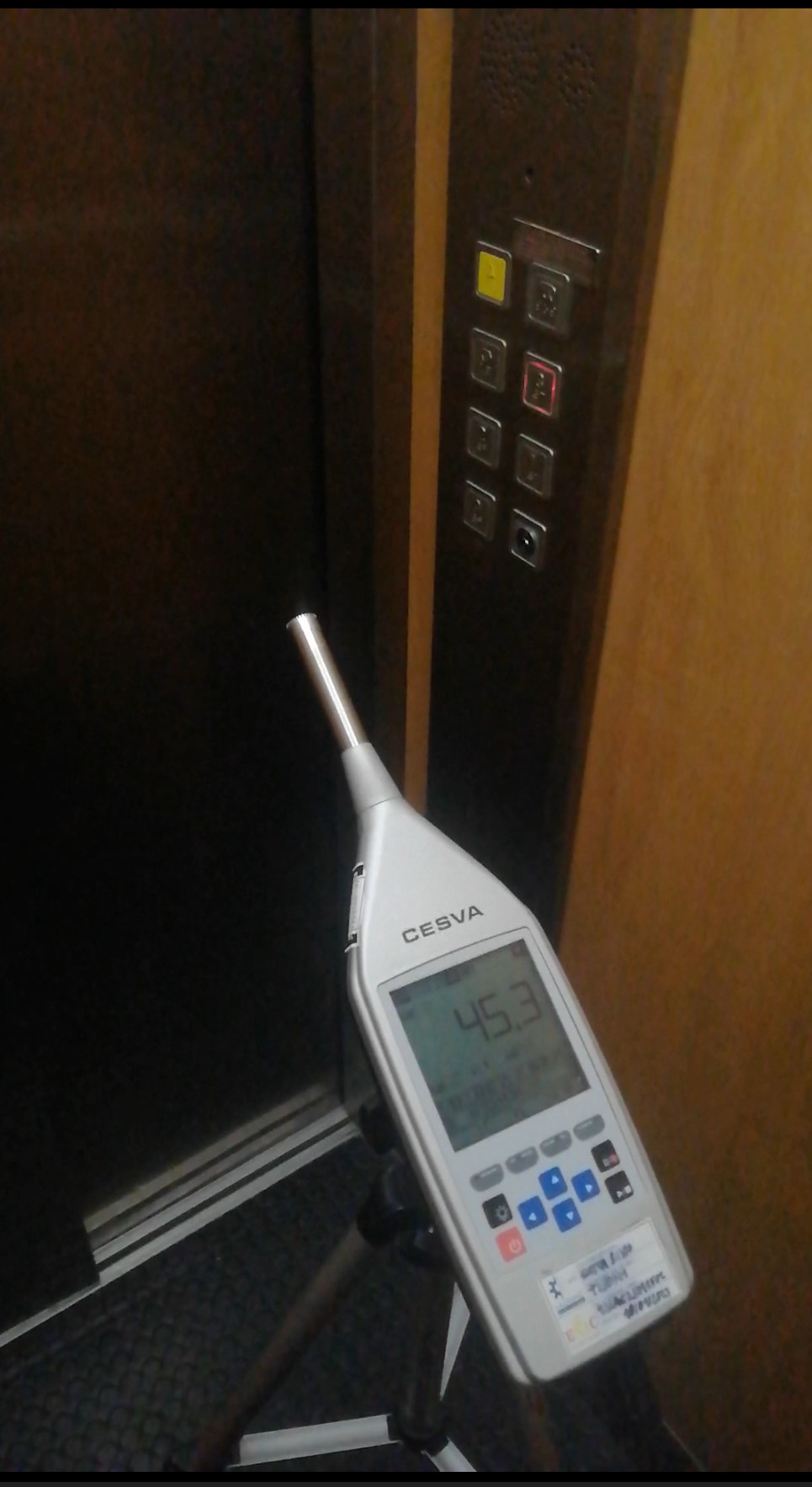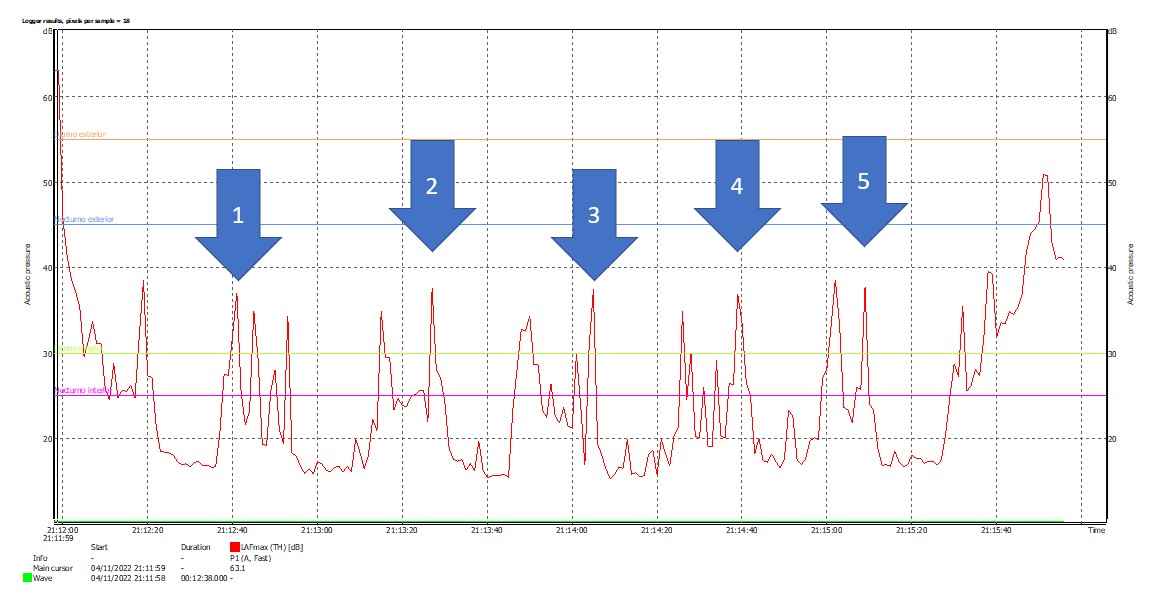Elevator noise
The noise law and the technical building code prescribe the performance of noise measurements in buildings to ensure compliance with legal limits.
It is common for elevators, parking doors, air conditioners and other building equipment to produce impulsive noise that is disruptive and annoying. Moreover, it is produced at any time of the day, even by neighbors who do not wish to disturb.
The regulatory framework is framed within the:
Noise Law 37/2003, of November 17, 2003.
The maximum noise for an elevator is, generically:
- 25/30 dBA for rooms
- 30/35 dBA for other rooms
- 45/55 dBA for common spaces
Considering night / day.

Noise measurement at the landing. The maximum allowed at night is 45 dBa.
Elevator noise control
The noise control of an elevator has some specific difficulties.
elevator noise and vibration should be measured
Thus:
- We will understand the nature and level of noise
- We will be able to better determine its origin
- We will know if it exceeds the legal limits.
Noise from old elevator machinery

Measurement in front of the elevator machine room
It should be checked that the elevator machinery is in good condition, is not aged and is well maintained, greased and does not produce strange noises or squeaks. The repair of the machinery is priority to any other action.
Older elevator machinery tends to produce much more noise because:
- The parts are worn and acquire exentricities and twists.
- They use old elements such as contactors and relays that produce clicks.
- They use older technology.
Noise in the elevator shaft
The elevator shaft can act as a sounding board and cannot be easily insulated due to its large size, the presence of doors, drive mechanisms, guides, etc. In some properties there are even bathroom windows and vents facing the elevator shaft, or the elevator shaft runs through the center of the staircase.
Noises are also produced in the shaft due to friction of the guides, opening and closing of the interior doors of the gondola and of the elevator access doors on each floor.
On the other hand, the machine room cannot be 100% acoustically isolated from the shaft, as holes are required for the cables to pass through. The cables themselves and the vibrations transmitted through the structure of the building pass noise into the shaft, which distributes it to all floors.
The elevator noise is transmitted through the structure.
If the elevator machinery is not well insulated, vibration is transmitted to the structure and this is transformed into noise . This noise can reach more distant houses and if it enters in resonance the structure of the building it can be amplified to a great extent.
To avoid this, the elevator machinery must be mounted on a "silent-block" shock absorber bed.

Need for acoustic and structural noise insulation
Noise must therefore be isolated both in its airborne and structural path. Therefore, it may be necessary to supplement vibration isolation with airborne sound insulation of the entire elevator machinery enclosure.
If it is found that the elevator is making annoying noises, it should first be discussed with the president and the community of neighbors so that appropriate measures can be taken. It is quite possible that there are more homes affected.
contact us elevator noise measurement
Rent our sound level meters, we will provide you with a report and advice.
What record is obtained?
With the instrumentation we provide, we obtain a graphic and acoustic record of the elevator noises.
The measurement protocol for noise produced by machinery and discontinuous cycles requires a minimum of 3 measurement cycles. In addition to the limits established for Laeq, it is established that for these events that for Lafmax the value measured in the most unfavorable event must be less than 45dB (A). The Lafmax parameter has the following sound level meter configuration:
- Weighting A
- Fast average time ("fast")
- Maximum peak value
All these indications are recorded in any of the sound level recorders that we have available. The result obtained is similar to this one in which you can see the trace left by 5 up/down cycles of an elevator.

Noise recorded 5 elevator cycles
In these cycads, they are easily observed:
- Maximums in the start and stop of the elevator. Produced by the actuation and braking of the motor and in some farms by the contactors.
- An intermediate plateau where the noise remains, in which some peaks due to clicks and friction are present. In this interval, the friction of the guides and the noise of the elevator motor can be heard.
- Noises are heard when starting and stopping due to the opening and closing of the gondola doors.
- Noise from the landing door can also be aidoble.
What to do if I have elevator noise?
Communicate to the community
In the first place it is necessary to communicate with the presidency of the community of neighbors so that it takes the opportune measures, calling the installation company so that it evaluates the situation and proposes the opportune measures. If no results are obtained we will be able to, successively.
Complaint to the city council
If no results are obtained, the situation can be reported to the city council and request that they send acoustic services to take measurements and check the level. It is frequent that the city council does not collaborate or does not have the necessary means.
If the noise measurements carried out by the municipality indicate excessive noise, the municipality may open proceedings against the community and threaten sanctions (from fines to the sealing of the elevator).
Perform noise measurements
You can measure the noise produced by the machinery yourself: for this you can use one of our sound level meters for rent. In this way you can know the magnitude of the problem and whether legal action is possible. It should be noted that the maximum levels set by municipalities (25 dBA) are still audible.
Open a civil proceeding
If the other options have failed, civil proceedings may be opened and may be directed against:
- The builder of the apartment, in the case of a new building. The responsible technician(s) will be sued for hidden defects and non-compliance with the Technical Building Code.
- The lessor, in case he is a lessee.
- The community of neighbors, in the event that it does not act.
The legal procedure can be very long. In the same procedure, it is possible to claim the correction of the noise and compensation for damages.
Contact to measure elevator noise
Rent our sound level meters, know the noise level and negotiate with your community.

